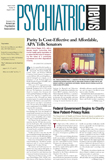The pharmaceutical industry is, of course, in the business of researching, developing, and marketing medications—an expensive, labor-intensive, and time-consuming process. Governed by profit-seeking stockholders, the companies aggressively market their products, many of which provide great benefits to patients throughout the world. However, according to some who are critical of the industry, the significance of the marketing wars surrounding competing medications lies not in patient benefit, but solely in the numbers. The latest example of such a war, involving several antipsychotic medications, is no exception (
see story on page 17).
The global antipsychotic market has been estimated by pharmaceutical industry analysts at more than $3.25 billion annually to treat just schizophrenia. When the growing market for acute mania, refractory depression, and the psychosis that can often be associated with dementia is added in, sales of antipsychotic drugs ballooned to more than $4 billion in 2000, according to the Pharmaceutical Research and Manufacturers of America (PhRMA.)
These types of revenue numbers are often touted in the popular press as evidence of rampantly inflated profits at pharmaceutical companies. A recent study by Families USA claimed that its analysis of data from pharmaceutical company financial statements showed that drug makers spend nearly twice as much to advertise their medicines as to research and develop them. But taken in context, they show just the opposite. Studies by Duke University economist Frank Grabowski found that while profits from so-called “blockbuster” drugs can be as high as 20 percent, only 10 percent of all drugs approved by the FDA actually return a profit. Because the average drug entering the market today requires an investment of more than $700 million and seven to 10 years of research and development just to get to a filing with the FDA for a New Drug Application (NDA), profits from any blockbuster drugs are often eaten up by the six out of seven drugs in development that never make it to the marketplace.
While acknowledging that many drug prices are too high for patients to afford, especially without prescription coverage, many clinicians agree that the investment is certainly worth the price. Studies by Columbia University economist Frank Lichtenberg have indicated that view may well be right. According to Lichtenberg, new drugs—including true breakthroughs as well as variations of existing drugs—reduce medical costs, increase productivity, improve quality of life, and boost life expectancy.
A recent study of the market for antipsychotic drugs by Decision Resources, a pharmaceutical industry analysis firm that specializes in advising companies on the launch of new drugs, projected that by 2004, sales of atypical antipsychotic medications will represent nearly 90 percent of the total antipsychotic market. The report said that the atypical drugs should maintain that dominant position through the end of the first decade of the century. It also projected that “the arrival of new serotonin-dopamine antagonists and short- and long-term injectable (depot) formulations will be the primary reasons for growth.”
The Decision Resources study also commented that the freedom from weight gain that ziprasidone (Geodon) enjoys and the marketing muscle of its maker, Pfizer, should combine to make ziprasidone a “formidable competitor” in the market. However, according to the study, olanzapine (Zyprexa), made by Lilly, and risperidone (Risperdal), marketed by Janssen, should remain the market leaders throughout the first decade of the 21st century.
The world’s most popular antipsychotic, olanzapine, has consistently taken over the lead in every market where it has been approved. According to Lilly, olanzapine is now available in 82 countries with more than 6 million prescriptions written since it was introduced in fall 1996.
Meanwhile, Pfizer’s fortunes depend significantly on the success of Geodon, finally launched after an unusually protracted four-year battle with the FDA for U.S. marketing approval (Psychiatric News, March 2). The FDA, in the end, agreed with the company that the lack of weight gain associated with ziprasidone outweighed potential cardiac risks. If Pfizer is able to open up more markets, allowing it to add to its current sales in the U.S. and Sweden (the only other country where ziprasidone is currently available), industry analysts say the drug could reach $1 billion in annual sales within two to three years.
With at least two new competitors hoping to join the antipsychotic market, it’s no wonder then that the marketing teams at Lilly, Pfizer, and Janssen have been especially busy lately.
